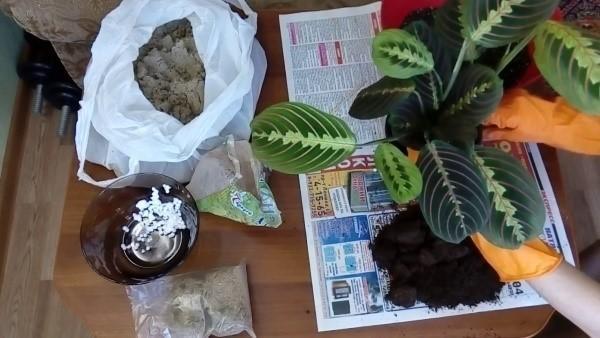How is a purchase arrowroot transplant carried out
 Transplanting arrowroot is an integral procedure for growing this beautiful plant. Although the flower develops slowly, in a couple of years its roots will become cramped in the pot. They will nourish the bush worse, which will affect its appearance. In addition, over time, the soil in the flowerpot cakes and becomes poor. The soil without nutrients, moreover, knocked down and dense, will no longer be able to give the flower a good basis for development. A transplant will help avoid these problems. It will provide the plant with light, nutritious soil and room to grow.
Transplanting arrowroot is an integral procedure for growing this beautiful plant. Although the flower develops slowly, in a couple of years its roots will become cramped in the pot. They will nourish the bush worse, which will affect its appearance. In addition, over time, the soil in the flowerpot cakes and becomes poor. The soil without nutrients, moreover, knocked down and dense, will no longer be able to give the flower a good basis for development. A transplant will help avoid these problems. It will provide the plant with light, nutritious soil and room to grow.
You should not ignore this procedure even if the arrowroot has just been purchased. Often, pots in stores last too long, and the conditions for their maintenance are completely different from home ones. Today we will discuss why a transplant of a purchased arrowroot is specifically needed. We will also find out when and how to transplant an adult plant that has been living at home for several years.
Two reasons to transplant purchased arrowroot
Some growers prefer not to touch the purchased plant, leaving it to grow in a store pot. But it often happens that a beautiful bush at home on the counter begins to fade and wither.
The reason for this phenomenon may be:
- Shipping soil. Most often, the plants are sold in peat substrate. They get food in nurseries and shops in the form of fertilizers. Home care is fundamentally different from this kind of growing. The main source of food for a flower in a pot will be soil, which is not there yet. Top dressing only plays an additional role. Arrowroots growing in peat, it is necessary to transplant. If this is not done, the flowers will starve when the "diet" is changed, moreover, they are easy to pour.
- Damage not visible at first glance. Arriving at the store, we see only the aerial part of the arrowroot and do not know what is happening with the roots. It happens that flowers are sold already filled, with rotten roots. A transplant will help determine the presence and extent of damage and take action in time. In this case, it is important to completely get rid of the old soil and rotten roots.
A lighter transplant (transshipment) option is allowed for arrowroot grown in domestic nurseries. There, most often, flowers do not grow in peat, but in the soil substrate. However, transplanting is recommended to check the condition of the roots and add drainage (usually not).
Arrowroot transplant: how often and how to do it right
So, why do we need a transplant of the purchased arrowroot, we figured it out. Young plants grown at home from cuttings need to be replanted annually. Adult arrowroots are often not worth worrying about. They themselves will tell you that a new pot is needed: roots will begin to crawl out of the drainage holes.
The optimal time for transplanting healthy arrowroot is spring. It is advisable not to touch the flowering bushes and wait until the end of flowering. If the plant is sick, the transplant should be done immediately.
The transplant procedure itself is simple and consists of the following:
- water the bush;
- carefully remove from the old pot;
- if it is not a transshipment, completely rob the land;
- inspect the roots, cut out all the rotten ones;
- in adult plants, too long roots can be slightly shortened;
- lay drainage on the bottom of the pot;
- cover with a layer of fresh substrate;
- install arrowroot on it and add soil;
- water abundantly.
In the first month after transplanting, watering arrowroot should be done carefully.The pot must be placed on a warm window with diffused lighting. But for diseased plants, it is better to organize a greenhouse so that they take root faster.